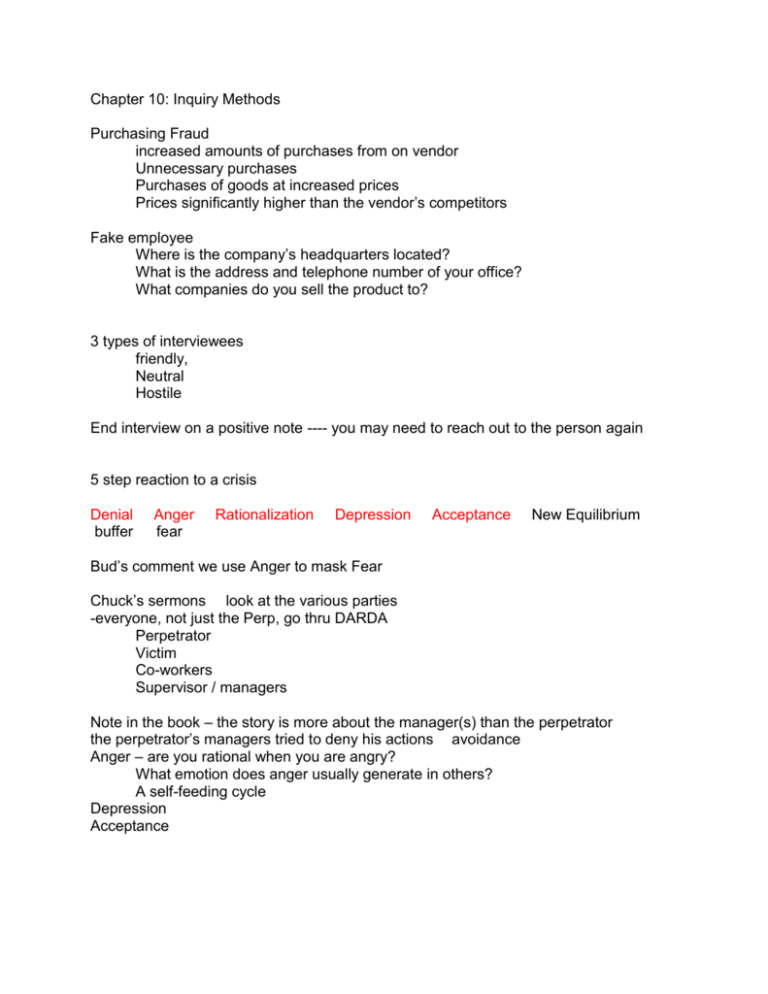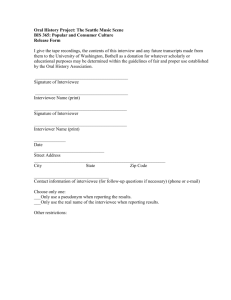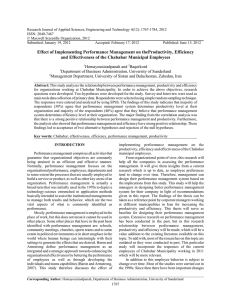Chapter 10
advertisement

Chapter 10: Inquiry Methods Purchasing Fraud increased amounts of purchases from on vendor Unnecessary purchases Purchases of goods at increased prices Prices significantly higher than the vendor’s competitors Fake employee Where is the company’s headquarters located? What is the address and telephone number of your office? What companies do you sell the product to? 3 types of interviewees friendly, Neutral Hostile End interview on a positive note ---- you may need to reach out to the person again 5 step reaction to a crisis Denial buffer Anger fear Rationalization Depression Acceptance New Equilibrium Bud’s comment we use Anger to mask Fear Chuck’s sermons look at the various parties -everyone, not just the Perp, go thru DARDA Perpetrator Victim Co-workers Supervisor / managers Note in the book – the story is more about the manager(s) than the perpetrator the perpetrator’s managers tried to deny his actions avoidance Anger – are you rational when you are angry? What emotion does anger usually generate in others? A self-feeding cycle Depression Acceptance The Supervisor Types of pressures financial pressure Vise pressures Work-related pressures Other pressures spent life savings cocaine and alcohol Symptoms Accounting Anomalies Internal Control weaknesses Analytical Anomalies Extravagant Lifestyle Unusual Behavior Tips and Complaints A customer complaint triggered the investigation Unusual behavior Lost his family -- divorce?? Frequent mood swings Frequent tardiness and absences Interviews prepare – prepare - prepare Know as much as possible about the offense Know as much as possible about the interviewee Remember not all interviewees are suspects, some may just have information to move the investigation forward 5 types of questions Introductory Informational Closed Open leading Assessment Assess the truthfulness of their answers Closing Do you know anyone else I should talk with? Is there anything I forgot to ask you that is relevant? Can I talk to you again if the need arises? End on a positive note Admission-Seeking Inhibitors of Communication It is the interviewer’s responsibility, not the interviewee’s responsibility, to remove the inhibitors of communication A bunch of environmental inhibitors; time, place, etiquette, confusion Interviewer Clear, concise questions Don’t talk down to them Don’t condemn Their Ego Repression --- have they repressed the info or truly forgotten Disapproval – don’t condemn, be accepting Loss of status Facilitators of Communication Expectations – expect that the interviewee will cooperate and be honest state that you anticipate that the interviewee will cooperate and answer questions truthfully When you change the way you look at things, The things you look at change New experience for the interviewee Catharsis --- you need to listen Focus on their answer --- rather than the next question you are going to ask Mechanics In private --- out of sight of friends and co-workers State the purpose of the general purpose of the interview without being specific or accusatory Ask for help (assistance) Get a commitment for cooperation Get a commitment for truthful answers Non sensitive questions first o Move from non sensitive to sensitive Agree wherever you can Ask some questions where it easy for them to say YES P 289 --- Informational Questions Begin by asking questions that are unlikely to cause respondents to become defensive or hostile Ask questions in a manner that develops the facts in the order of their occurrence or in some other systematic order Ask one question at a time, and frame the question so that only one answer is required Ask straightforward and frank questions (don’t try to be shrewd) Give respondents ample time to answer; do not rush Try to help respondents remember without suggesting answers Repeat or rephrase questions, if necessary, to get the desired facts Be sure you understand the answers. If they are not perfectly clear, have respondents interpret them at that time instead of saving this for later Give respondents an opportunity to qualify their answers Separate facts from inferences Have respondents give comparisons by percentages, fractions, estimates of time and distance, and other such comparisons to ascertain accuracy Get all of the facts: almost every respondent can give you information beyond what was initially provided After respondents give a narrative account, ask questions about the items discussed Upon concluding the direct questioning, summarize the facts and have respondents verify that summary is correct Destruction of evidence is a risk










